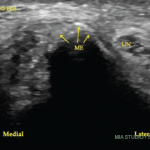Ironically, chronic exposure to minocycline has also been associated with a variety of autoimmune syndromes, including drug-induced lupus, autoimmune hepatitis, serum sickness and vasculitis.1 Minocycline is associated with an 8.5-fold increased risk of drug-induced lupus.2 Minocycline and nitrofurantoin are implicated in 90% of cases of drug-induced autoimmune hepatitis.3 Minocycline-induced vasculitis is much less common and, therefore, may not receive appropriate consideration.
We present a case of polyarteritis nodosa (PAN), primarily affecting the lower extremity peripheral nerves and skin, that improved only after minocycline was recognized as the culprit and stopped.
Case Presentation
A 40-year-old man presented with 10 days of pain, stiffness and swelling in his hands, wrists, shoulders, ankles and feet, along with generalized myalgias. He had a history of acne vulgaris, which had been treated with minocycline for the previous three years. His past medical history was otherwise unremarkable.
He denied having a rash, fever, chills, dyspnea, abdominal pain, chest pain or paresthesias. He had tender, non-swollen joints in his fingers, wrists, shoulders, ankles and feet.
His initial laboratory tests showed an erythrocyte sedimentation rate of 17 mm/hr (reference range: 0–15 mm/hour in men younger than 50) and a C-reactive protein level of 3.8 mg/dL (reference range: <0.5 mg/L); rheumatoid factor (RF) and anti-nuclear antibodies (ANA) were absent. He was started on 20 mg/day of prednisone, which was tapered over four weeks and quickly felt better. He was referred to our rheumatology service for further evaluation.
At the time of his initial consult visit with us, he had finished his prednisone taper and was experiencing recurrence of his joint pain. He had no rash or joint swelling on examination. Laboratory tests were remarkable for C-reactive protein of 2.3 mg/dL, a positive ANA (titer 1:160, speckled pattern) and an elevated white blood count of 12.3×103/mcL (see Table 1). He did not have antibodies against extractable nuclear antigens, anti-nuclear cytoplasmic antibodies (ANCA), RF or anti-cyclic citrullinated peptide antibodies (ACPA). His muscle enzymes and urinalysis were both normal, as was his chest X-ray.
Patients with minocycline-associated vasculitic neuropathy respond quickly (within four to 12 weeks) to the antibiotic’s withdrawal.
He was placed back on prednisone 40 mg/day with a slow taper. Hydroxychloroquine 400 mg/day was started. Within eight weeks, he was able to reduce his prednisone dose to 5 mg/day without recurrence of his joint symptoms; however, he developed shooting pain, numbness and tingling in the feet and ankles. He also noticed an episodic, fleeting, erythematous exanthema on his lower extremities.
Table 1: Laboratory Tests at Presentation to the Rheumatologist
| Laboratory | Test Result* | Reference Range |
|---|---|---|
| White cell count | 12.3x103/mcL | 4.0x103/mcL–10.0x103/mcL |
| Hemoglobin | 14.8 gm/dL | 13.5–17.5 gm/dL |
| Platelet | 312x103/mcL | 140x103/mcL–450x103/mcL |
| Serum creatinine | 0.84 mg/dL | 0.64–1.27 mg/dL |
| Aspartate amniotransferase (AST) | 27 IU/L | 15–41 IU/L |
| Alanine aminotransferase (ALT) | 28 IU/L | 50–280 IU/L |
| Uric acid | 3.3 mg/dL | 1.2–7.6 mg/dL |
| Creatine phosphokinase (CK) | 81 IU/L | 50–280 IU/L |
| Alsolase | 4.1 units/L | 1.2–7.6 units/L |
| C-reactive protein | 2.3 mg/L | <0.5 mg/L |
| Anti-nuclear antibody (ANA) | 1:160 titer (speckled) | <1:80 titer |
| Anti-SSA (Ro) | 6 units | <20 units |
| Anti-SSB (La) | 2 units | <20 units |
| Anti-double-stranded DNA (Crithidea indirect fluorescent antibody) | negative | negative |
| Anti-Smith | 4 units | <20 units |
| Anti-RNP | 16 units | <20 units |
| C3 complement | 129 mg/dL | 79–152 mg/dL |
| C4 complement | 26 mg/dL | 15–46 mg/dL |
| Anti-neutrophil cytoplasmic antibody (ANCA) | <1:20 titer | <1:20 titer |
| Anti-cyclic citrullinated peptide IgG (ACPA) | 6 units | <20 units |
| Rheumatoid factor | <15 IU/mL | <15 IU/mL |
| Hepatitis B surface antigen | negative | negative |
| Hepatitis C antibody | nonreactive | nonreactive |
| Lyme antibody | 0.09 | <0.9 |
| Urine blood | <1/HPF | 0–2/HPF |
| Urine protein | negative | negative |
| *abnormal findings indicated in bold |
His prednisone was increased back to 40 mg/day, and electromyogram (EMG)/nerve conduction studies were ordered. Further laboratory testing demonstrated normal serum protein electrophoresis, hemoglobin A1c, B12 and thyroid-stimulating hormone. He did not have antibodies against syphilis, hepatitis B or hepatitis C. His EMG/nerve conduction test showed bilateral sensorimotor polyneuropathy with absent sural and diminished posterior tibial nerve responses, consistent with mononeuritis multiplex.

